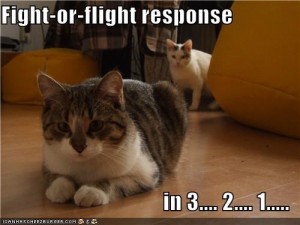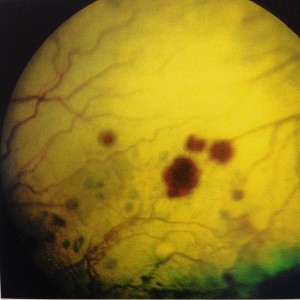A lot of us are minding our blood pressure, and maybe even on meds to manage blood pressure.
Not many people, however, realize that blood pressure can be an issue for pets too.
Blood pressure can be too high or too low; high blood pressure in particular is a concern, because of the risk of organ damage that it poses.
Both cats and dogs can develop high blood pressure, but cats face it more often than dogs do.
Why does high blood pressure happen?
- Kidney disease – some of the main blood pressure “sensors” are in the blood vessels leading to the filtration units in the kidneys. This is because blood pressure is important for the filters to work right; a certain pressure through them needs to be maintained. In diseased kidneys, these signals get mixed up and tell the body “we need more blood pressure!”
- Heart disease – if the heart is not able to pump as well as it used to, then its output of blood with each pump may not be enough to meet the needs of the tissues. Increasing blood pressure is meant to be a temporary way to increase cardiac output – think of increasing the pressure in the output of a garden hose by sticking your thumb over the end to make it squirt farther. Doing this temporarily, like in a “fight-or-flight” situation is OK, but it is not meant to be kept up 24/7.
- Hormone problems – in cats, the big hormone issue that can cause hypertension is hyperthyroidism (a thyroid gland that is overactive because of a tumour in it). In dogs the big hormone issue is “Cushing’s disease” (adrenal glands that are overactive because a tumour in the pituitary gland sends out too much hormone to turn them on)(See a dog with Cushing’s Disease here). More rare are tumours in the adrenal glands themselves.
- “Idiopathic” hypertension – Idiopathic just means “it happens because it happens”. This is what we use to describe high blood pressure where we can discern no other cause.
What does high blood pressure hurt?
- The kidneys – too much pressure causes the kidney filter units to leak out protein, which damages the kidney tubules. Sometimes it can be a real “chicken and egg” scenario to figure out: do we have high blood pressure because of damaged kidneys, or did we damage the kidneys because of high blood pressure?
- The heart – upping the blood pressure to make the blood pump farther is supposed to be a short term part of the “fight or flight” response.
 After the crisis is over, the animal is supposed to hunker down under a bush somewhere and let the heart rate and blood pressure go back to normal. If the blood pressure goes up because the heart is not working as well anymore, then there is no “back to normal”… and now the already weakened heart is having to push blood out against a high pressure, working harder and wearing out faster.
After the crisis is over, the animal is supposed to hunker down under a bush somewhere and let the heart rate and blood pressure go back to normal. If the blood pressure goes up because the heart is not working as well anymore, then there is no “back to normal”… and now the already weakened heart is having to push blood out against a high pressure, working harder and wearing out faster. -
The eyes – the high blood pressure can cause small blood vessels to burst in the eyes. This is one of the things we look for in an exam: little hemorrhage “apples” on the branches of the retinal blood vessels “trees”. Big enough hemorrhage can cause the retina to detach, leading to blindness.
- The brain – we worry about strokes in pets, just like in humans. In cats, these sometimes take the form of “mini strokes” which can result in episodes of confusion, sometimes presenting as crying at night.


